Plant Leaf Disease Detection Using Machine Learning
The Project presents plant leaf disease detection, effect of disease on plant yield and what pesticides should be used for its cure. In agriculture, research of automatic plant disease is essential one in monitoring large fields of plants, and thus automatically detects symptoms of disease as soon as they appear on plantleaves.

Our research aims to solve the problem of detecting and preventing diseases of agricultural crops.. To determine the optimal architecture for deep learning, we considered severalmodels.Asasourceofthetrainingdata,weusethe PlantVillage open database For this approach automatic classifierConvolutionalNeuralNetworks(CNN)modelwill be used for classification based on learning with some training samples. The developed model is deployed as a web Application which can detect 15 types of diseases amongplantsviz.Tomato,PotatoandPepper.
Validation Accuracy Results show that the system can show the accuracy 93.50 % and Training Accuracy is approximately97.87%
Key Words : plant leaf disease, Plant Village Dataset , pesticides, CNN, Accuracy.
INTRODUCTION
Plants have become a major source of energy and are a critical component in the solution to the global warming crisis. Several plant diseases have the potential to bring disastrous economic, social, and ecological consequences. To meet projected demand, worldwide crop production mustincreasebyatleast50%by2050.
Currently, the majority of production takes place in Africa and Asia, where 83 percent of growers are family run businesses with little to no horticultural experience. As a result, yield losses of more than 50% are common as a result of pests and diseases. The old approach of human analysis by visual inspection is no longer viable for categorizingagriculturaldiseases.
The main goal of this project is to identify the most common diseases seen in Plant Leaf. Tomato, potato, and pepper are the three types of plants employed in this research. This system can detect 15 different forms of illnesses in these three plants. The user can upload a leaf
image,andiftheleafhasadisease,thenameofthedisease, as well as the prescribed pesticides, will be presented on theuser'sscreenafterpressingthepredictbutton.Ifthere is no disease in the plant leaf after uploading the image, a messagereading"ThereisnodiseaseonthePlant"willbe displayed. The system also displays the proportion of impacted areas and recommends pesticides based on that percentage.
Need of plant leaf disease detection:
Wehaveallseenhowthefarmersaswellasallthepeople get Infected due to distortion of plants due to various diseases.Thisproblemnotonlyaffectsthefarmersincome butitalsoaffectstheconsumersduetoshortageofsupply. The estimated loss due to plant leaf disease is 60 billion dollarswhichisahugeamountofmoney.
Oneofthemostimportantneedsofthis projectistheease ofdetectionof thedisease bythefarmersina verysimple manner as farmers cannot predict the disease just by looking at the leaf. This system will also help farmers identifythediseaseandalsorecommendcertainpesticides which they can use to cure the disease and stop further spreadofthediseaseasifoneplantleafisInfectedthereis a chance that disease might spread on many leaves and destroytheTotalyield.
PROBLEM STATEMENT
To make an efficient use of Machine Learning Algorithms whichreducestimeandcostforFarmertodetecttheplant disease, its effect on crop yield and suggest the pesticides forPlantdisease.
II. SCOPE
This project will be very helpful to farmers in rural areas andalsowillhelptheminsavingtheiryieldsfromdiseases as farmers lose a huge amount of their cultivated crops becauseofdiseasesandthissystemwillhelpthemtoavoid thesimilarsituation.Alsowehavetriedtoimplementthis project in a regional language so as to make things more understandableforfarmers.
This project can also provide them cure by suggesting pesticide names and their quantity according to the
International Research Journal of Engineering and Technology (IRJET) e ISSN: 2395 0056 Volume: 09 Issue: 04 April 2022 www.irjet.net p-ISSN: 2395-0072
prevailing disease and this project will also display and giveanideaabouttheeffectofcropdiseaseoncropyield.
III. RELATED WORK
There are different algorithms and methodologies for identifying the disease on plant leaves. There are many different organizations and many researchers who have studied and have done work on this topic using different algorithms.Someofthemaresummarizedbelow.
Inpaper[1],In2018intheInternationalJournalofScience andEngineeringApplicationsMr.KoKoZaw,Dr.ZinMaMa Myo,Mr. Daw Thae Hsu Thoung proposed Image processing is the only way to build the simple, robust and accurate disease detection system While working with imageprocessing.Detailedstudiesshouldbeperformedon the types of diseases, their symptoms, and the patterns of disease.Thesystemwillbedesignedbasedonthepatterns of disease. The mainly occurring diseases on leaves are Bacterial disease, Fungal disease, Viral disease and diseases due to insects. These diseases are detailed in the paper.
Inpaper[4],In2018inInternationalConferenceonDesign Innovations for 3CsComputeCommunicateControl Shima Ramesh, Mr. Ramachandra Hebbar, Niveditha M, Pooja R, Prasad Bhat N, Shashank N,Mr. P V Vinod proposed According to past studies, 42% of agricultural production is in Loss, and that too solely as a result of plant leaf diseases. With this technique, plant leaf diseases can be detected from input images to overcome this major issue. This process involved steps like image preprocessing, image segmentation, feature extraction. On the basis of thesethreesteps,KNearest Neighbor(KNN)classification is applied. As a result of the proposed implementation, A 98.56%accuracyrateinpredictingplantleafdiseases.
In paper [5], In 2021 in BMC(Biomedcentral) Jun Liu and Xuewei Wang proposed plant disease and pest detection using SVM algorithm. SVM is used for recognizing image samples. The accuracy of implementation is about 92% withasufficientandstabledatasetusedfortheproject.
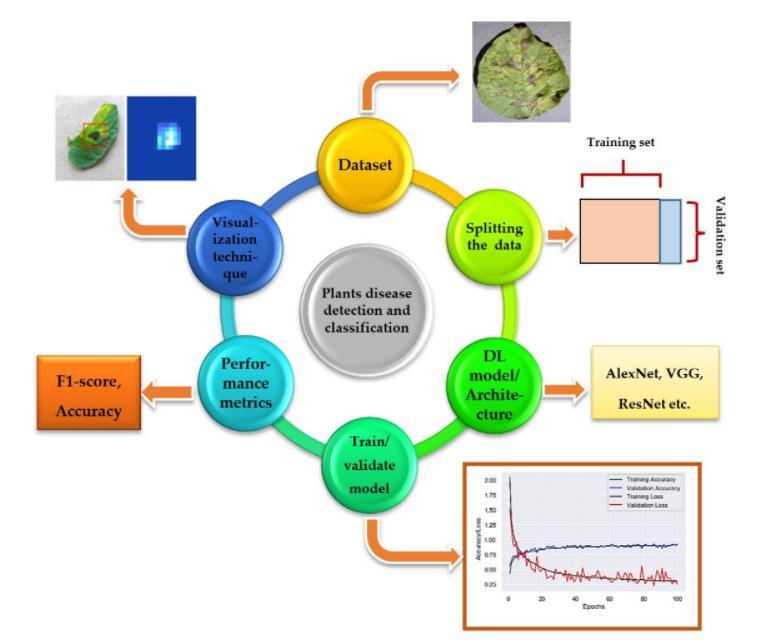
IV. PROPOSED SYSTEM
A. Introduction
Thefirststepisthefarmerwilluploadtheimageoftheleaf on the website. After uploading the image, farmers can clickonthepredictbuttonandwaitfortheresult.Forthis CNN algorithm , the keras module is used to train the
model and the Plant Village dataset is used for model trainingandvalidationoftheentiresystem.
Nowthereare two possibilitiesafter uploadingthe image: eithertheplantleafwillbeinfectedortheplantleafwon't be Infected. If the leaf is found to be infected the image of theleafwillbedisplayedonscreenalongwiththenameof the disease in English and Hindi language. Also the proposed system is capable of calculating the percentage area Infected and displaying it on the screen and also suggestingthepesticides on the basisof thearea Infected. The name of the pesticide, image of the pesticide is displayed along with the quantity and all of the information is displayed in two languages English and Hindi for better understanding of farmers as many of the farmers won't be able to understand name of disease in English but the farmers would be familiar with regional hindinamesofthediseasethatispresentonplantleaf.
Alternatively, if the leaf is not infected, the image along with the message "There is no disease in the leaf of the plant"isdisplayed.
B. Proposed Methodology
Plantleafdiseasedetectionsystemflowchart:

© 2022, IRJET | Impact Factor value: 7.529 | ISO 9001:2008 Certified Journal | Page 3114

3.
4. If the plant leaf has any disease, this page will show the name of the disease with the image of the leaf and upto how much extent the leaf is Infected. For eg. Here the plant leaf has ‘Potato EarlyBlight’diseasewith23.415%regionInfected whichisshownhere.
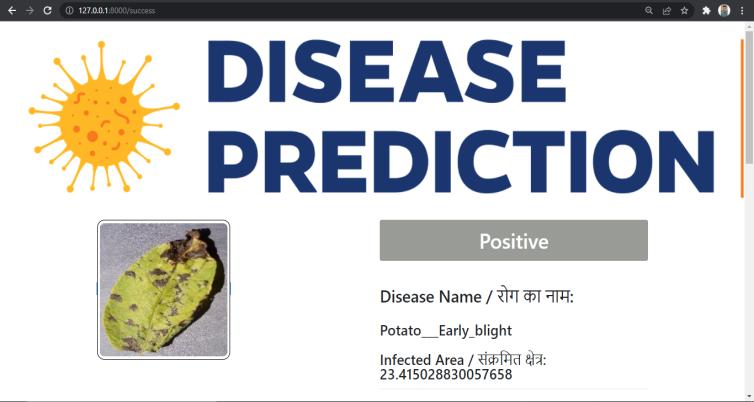
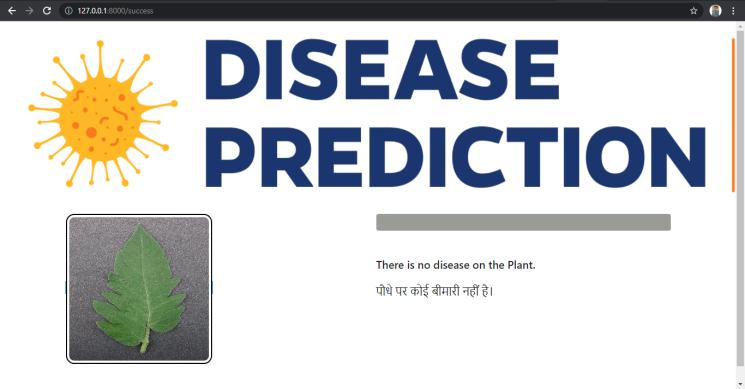
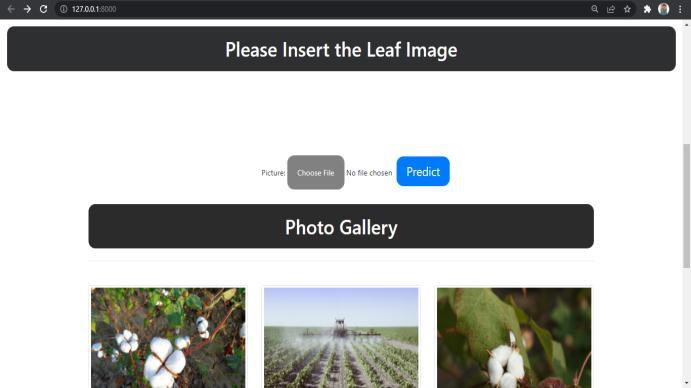
5. After predicting the disease, this page will recommendtheproductsthroughwhichtheplant

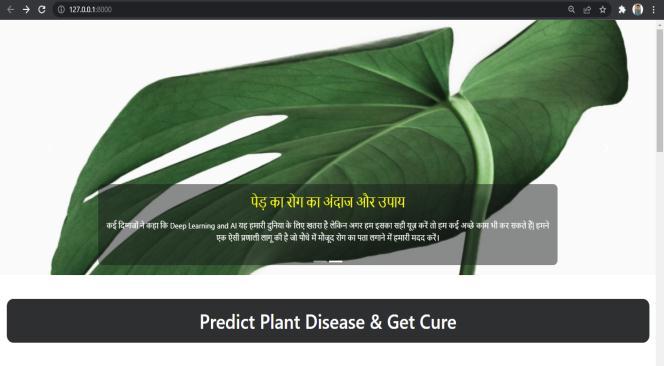

becured.

V. CONCLUSION
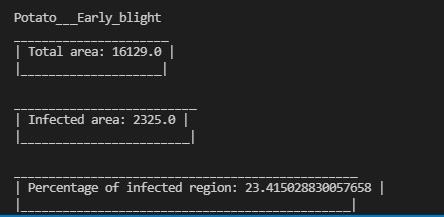

Topreventlosses,smallholderfarmersaredependentona timely and accurate crop disease diagnosis. We fine tuned a pre trained Convolutional Neural Network, and then deployed it online. The final result was a plant disease detectionapp.Thisserviceisfree,easytouseandrequires just a smartphone and internet connection. Overall, this study is conclusive in demonstrating how CNNs may be applied to empower small holder farmers in their fight againstplantdisease.Inthefuture,workshouldbefocused ondiversifyingtrainingdatasetsandalsointestingsimilar web applications in real life situations. Without such developments, the struggle against plant disease will continue.
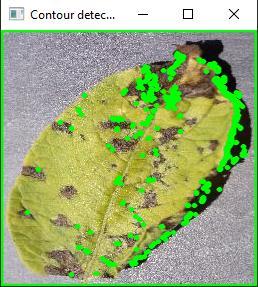
So Implementation of the project work was done successfully and we got to learn many more things from thisproject.

VI. ACKNOWLEDGEMENT
This project report would not be successful and final without the guidance and assistance of many people, and we are very fortunate to have received this during the completion of our project. Nothing we have accomplished ispossiblewithouttheirsupportandassistance,andallwe have accomplished is only because of such support and assistance.
It is with great respect and gratitude that we extend our thanks to Dr. Shalu Chopra, Head of the Department of InformationTechnology,forgrantingusthispermissionto performthiswork.Weareincrediblygratefultoherforthe nice support and guidance she provided to us throughout this project, in spite of her busy schedule managing the department.
Takinggreatinterestinourprojectworkandguidingusall along, till completion of our project work, we owe our deepest gratitude to our project guide, Mrs. Jayshree Hajgude, who helped us to develop a good report by providingall ofthe necessaryinformation.Also,wewould liketothankalltheauthorsnamedintheliteraturesurvey as well as the references section for sharing their discoveries with us. Getting to our goal would be virtually impossiblewithouttheircontributions.
VII. REFERENCES
1. The detection and classification of leaf diseases using Multiclass Support Vector Machines, 11th National Conference on Science and Engineering, Yangon,Yangon,Myanmar,KoKoZaw,ZinMaMa Myo,andWahWahHlaing.
International Research Journal of Engineering and Technology (IRJET) e ISSN: 2395 0056 Volume: 09 Issue: 04 April 2022 www.irjet.net p-ISSN: 2395-0072

2. A Survey of Disease Identification and Classification Through Leaf Images:A Computational MethodSukhvir Kaur, Shreelekha Pandey, Shivani Goel.Received: 26 June 2017 / Accepted: 11 January 2018 CIMNE, Barcelona, Spain2018
3. Shima RameshAssistantProfessor:departmentof electronics and communication, MVJ College of Engineering. Bangalore, India, 2018 International Conference on Design Innovations for 3Cs Compute Communicate Control Plant Disease DetectionUsingMachineLearning. Niveditha M, Pooja R, Prasad Bhat N, Shashank N, Research Scholar: department of electronics and communication,MVJcollegeofEngineering, Bangalore,India.
4. The detection of plant diseases and pests using deep learning: a review by Jun Liu and Xuewei WangPlantMethods(2021)17:22
5. 2017 IEEE International Conference on Technological Innovations in ICT For Agriculture andRuralDevelopmentIdentificationofPlantleaf disease using image processing. Pooja V, Rahul Das, Kanchan V, Department of Computer Science,AmritaSchoolofArtsandSciences,Amrita VishwaVidyapeetham, Amrita University, Mysuru Campus,Karnataka,India.
6. International Journal of Science and Engineering Applications Volume 7 Issue 08,143 147, 2018, ISSN: 2319 756 . Support Vector Machine Based Classification of Leaf Diseases Ko Ko Zaw, Department of Electronic Engineering TechnologicalUniversity,Thanlyin,Myanmar Dr. Zin Ma Ma Myo, Department of Electronic Engineering Technological University, Thanlyin, Myanmar
